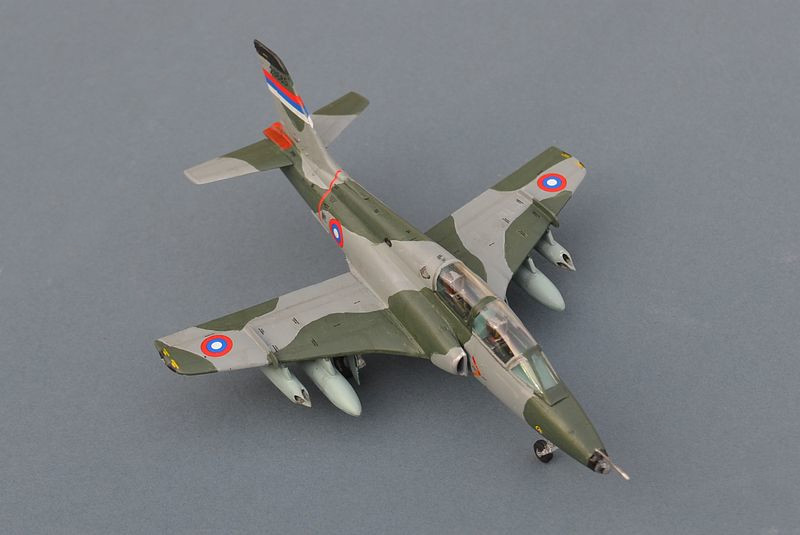March 2025
SOKO G4 Super Galeb
SOKO G4 Super Galeb
Republika Srpska Air Force (V I PVO VRS) -
Banja Luka (Mahovljani Air Base), Former Yugoslavia, 1992
Yumo 1/72
Text & Images © www.gengriz.co.uk (unless otherwise indicated)
This one dates back to the days when I mostly built models of subjects that I had
some connection with -
The Super Galeb (and next month’s Orao) were aircraft originally developed and operated by the Yugoslav Air Force. In the early 1990s, when that country splintered into many smaller warring states, aircraft, like much of the former Yugolsav armed forces' equipment, were split between the many factions.
Super Galebs were operated by two of the warring factions:
The Federal Republic of Yugoslavia (FRY) Air Force (essentially Serbia and Montenegro)
which operated 3 main combat types, the MiG-
The Bosnian Serb air forces (Republika Srpska) also operated Super Galebs, Jastrebs and Oraos.
Whilst we regularly saw Croatian and Serbia/Montenegran aircraft on radar (the Croatians
had a few MiG-
For this build, I have chosen the Bosnian Serb decal option, as an aircraft that I believe actively participated in the Yugoslavian Wars, representing an air force that only existed for a short time, then was absorbed into that of Bosnia Herzegovina and finally Serbia / Montenegro as a result of the Dayton Accords.
The Dayton Accords were a peace agreement signed 30 years ago (1995) by the main warring factions in the Former Yugoslavia, that put an end to three and a half years of bitter civil war in the main parts of the Former Yugoslavia. The Accords were roundly criticised at the time as unworkable, since they resolved little and solidified the religious, territorial and societal divisions that had led to horrors such as widespread ethnic cleansing and massacres of civilians, but all parties to the war, under intense pressure from the west and Russia, were exhausted and grabbed at the chance to stop the fighting.
Much to the surprise of many, the fragile peace has mostly held for the last 30 years, albeit with a continuing foreign (EU) military presence to help enforce the agreements.
2025 also marks the 30th anniversary of the main genocides of civilians in the Former Yugoslavia, as part of various factions’ efforts to “ethnically cleanse” the territory that they controlled.
Whilst few emerged from this war as innocent, some returned to decency quicker than others.
Building the YUMO Super Galeb kit:
This is one that I had fully intended to build last year, to mark 30 years since
the height of the Bosnian conflict and as one of the many aircraft types I have interacted
with in real life. Other builds overtook it, but my recent acquisition of a SOKO
Orao kit to go with it (also building this month) has prompted me to get it moving
in this, the 30th anniversary of the Bosnian genocides and the Dayton Accords.
The kit was produced in 1997 by YuMo (so far as I know, their only kit), with its most recent appearance in 2010 from "Lift Here Models". Mine was an original 1997 issue and its box tells me it was made in Beograd (Belgrade), Yugoslavia (now Serbia) and that I paid £7.99 for it at Wonderland Models in Edinburgh.
The box is sturdy with some nice box-
Construction is straightforward and conventional. Special mention must go to the ejector seats, undercarriage and weapons, all of which are very well moulded and detailed. I have seen other reviews criticising the ejector seats as crude, but a check with reference photos show them as a good replica of the Martin Baker seats fitted.
As is common with short-
The wing had some strange small (4mm?) tab like bits on quite a few parts that I couldn't decide whether they were flash or deliberate mouldings (I eventually decided they were flash). However, overall, this was not a difficult build and the level of surface detail is very creditable, resulting in a good looking replica at the end.
Paint is almost entirely Humbrol Enamel, with 127 for the greys and 30 for the greens, but with Revell 49 Light Blue underneath. Decals worked well (even though they are more than 25 year sold), but the many stencil markings are a little difficult to apply and not easy to tie up the application diagram and the decal sheet. The kit is not a tail sitter (just), which is just as well because I didn’t apply any weights.
Photos of aircraft during the war are not easily available, with pre war and post war Yugoslav/Serbian aircraft looking glossy and well maintained. However pictures of the stored Bosnian Serb aircraft do show a matted and worn finish, so that is what I have gone for, with a final application of W&N acrylic Matt Varnish.
I know that these kits have become very difficult to find in recent years, but I definitely recommend it as a good example of an unusual type, and if you should see one on sale at a reasonable price, you will not regret snapping it up!
Link to other Yugoslav models on my “Other Side” pages
Background Image and below: The blockaded Yugoslav coast viewed from HMS BRILLIANT,
looking toward the Kotor Inlet (Serbia-


Below: Blockaded Dubrovnik (Croatia) looking over HMS BRILLIANT’s guns.

Below: Super Galeb of the modern Serbian Air Force in 2010 (Photo Rob Schleiffert,
licensed under CC BY-
The G-
As well as its trainer role, a centre mounted gun pod could be fitted to mount a
double 23mm Gryazev-
During the Yugoslav Wars, G-
All remaining Super Galebs except one were eventually relocated to Serbia and Montenegro
where they entered service with the Air Force of the FRY. A single G-
The modern Serbian Air Force continues to operate Super Galebs and is now (2024)
the largest operator of the type, having acquired further airframes from other ex-








